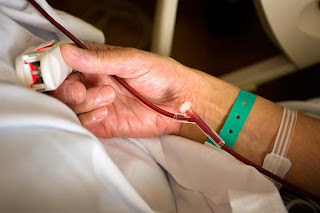100 Days
/
I've been "off the air" for some time acting as my wife Pam's primary caregiver while she's been recovering from a bone marrow transplant at the Lied Transplant Center/University of Nebraska Medical Center on July 12th. The 100 days following the bone marrow transplant have been closely monitored by the doctors as Pam's donated marrow grows and replaces the previously destroyed (by chemotherapy) marrow.
These 100 days following a transplant can be a perilous period as the patient is temporarily functioning without an immune system. A variety of immunosuppressive drugs are used to protect the patient, as well as a temporary lifestyle that avoids large crowds, prepared fresh foods, exposure to live plants—in other words, a hermit's existence. Pam has undergone twice-weekly blood tests to monitor her progress.
A potential danger in the wake of a bone marrow transplant is GVHD (Graft VS. Host Disease). The donor's bone marrow (the "graft") can potentially see the patient (the "host") as an unrecognized foreign invader. When this happens, the patient can suffer a variety of disorders affecting the skin, digestive system, and liver. During the first 100 days post-transplant, these effects are referred to as Acute GVHD. Beyond the 100 day period, they are referred to as Chronic GVHD.
I'm happy to report that Pam's 100 day exam revealed no GVHD. In fact, her recovery has gone very well. An interesting side effect of the transplant is that Pam's blood type has changed from type O to type AB. This is because the donor is type AB and the new marrow continues to produce this blood type. Pam's donor was a male. Consequentially, Pam's blood DNA now tests as male! As I like to say in my best Austin Powers voice, "She's a man, baby!".
In many ways, the 100 day mark feels like the closing of a chapter. Our lives are slowly beginning to return to normal. Pam is looking forward to returning to work. I'm anxious to focus on teaching once again. We'll have to live with the shadow of leukemia going forward—there is always the chance that it may return. However, there are many leukemia survivors out there. The photo of Pam was taken at the Cancer Survivor's Park here in Omaha.
We truly appreciate all of the positive messages that we've received during this period. It really makes a difference knowing that folks are thinking of Pam and have her in their prayers. Thanks to all who have purchased the Equinox print (It's still available!). The proceeds are helping to soften the blow of the medical costs associated with the transplant.
I'd like to especially thank Jinny Brown and Karen Bonaker for their efforts to set up and manage a contribution page, Gift of Life - a Tribute to Pam and John Derry. I had no idea Jinny and Karen had initiated this effort until I noticed that I was repeatedly getting PayPal Equinox print payments from Karen. Why would she buy multiple prints? A little googling provided the answer. Jinny and Karen: Thank you so much!
Hopefully, this will be the last time that I'll have to write about leukemia and bone marrow transplants. I intend to now return my focus to Painter, Photoshop, pixels, and all of the usual suspects.
And now, back to our regularly scheduled program...
-john


